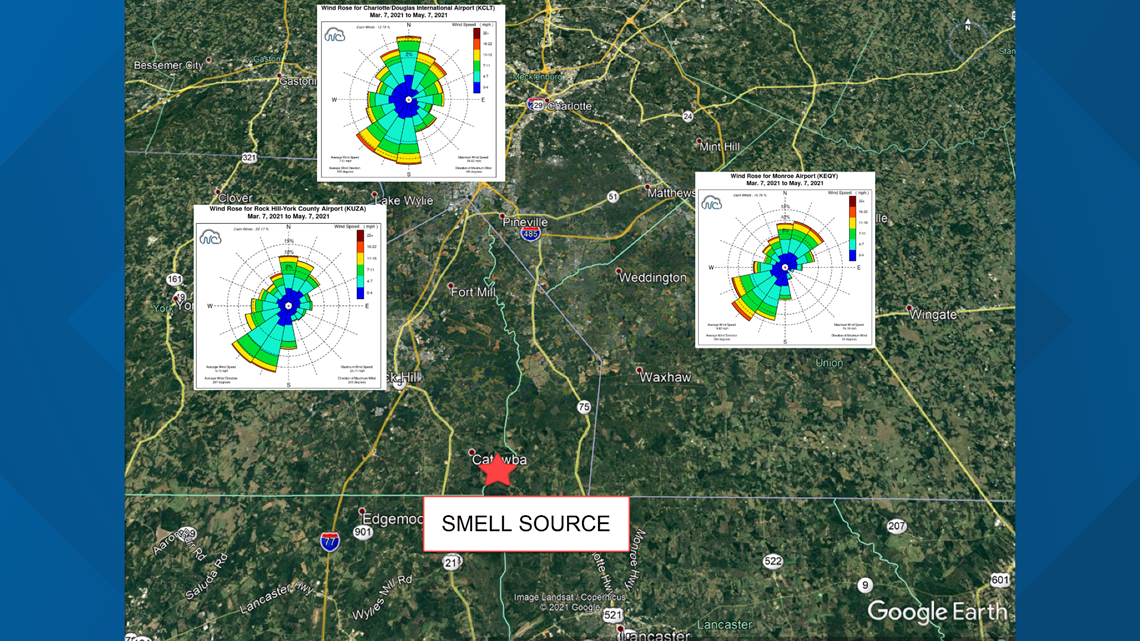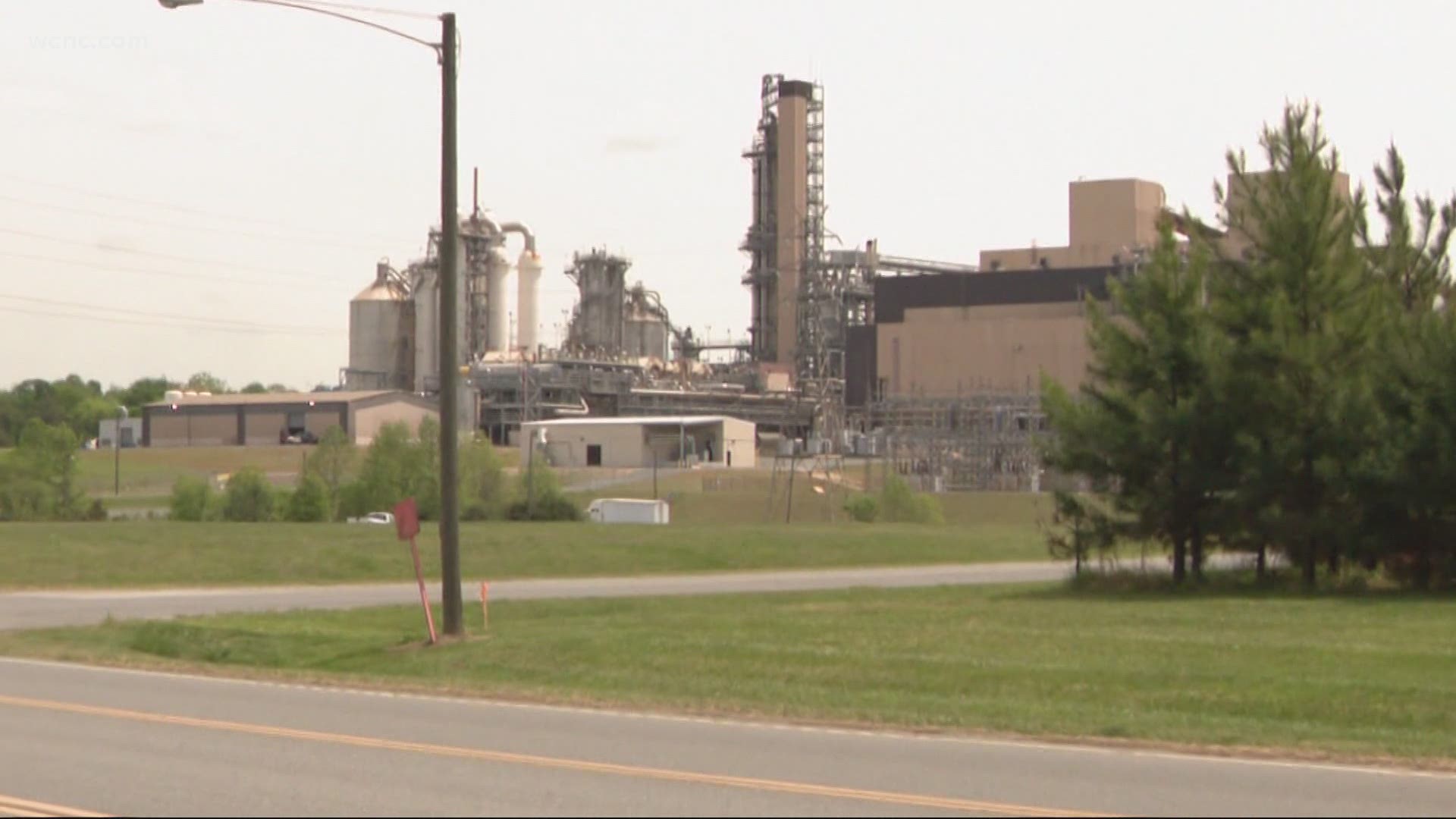CATAWBA, S.C. — After nearly three months and more than 17,000 complaints, the South Carolina Department of Health and Environmental Control reports the New Indy Containerboard mill in Catawba, South Carolina, is indeed the source of foul odors nearby residents have complained about.
Now, the agency is demanding the mill take action to cut down on the emissions causing the "rotten egg" smell.
"There's times when I just want to come home and walk my dog and I can't walk the dog because I can't breathe it, it irritates my lungs because the stench is so strong and sometimes it will just make me choke," Lancaster resident Michelle Stein said.
Many people have reported headaches, nausea, skin and eye irritation. Stein's husband has been greatly impacted.
"He's had to go to the emergency room three times for breathing trouble because his asthma is so bad since we've moved here," Stein said.
In a nine-page report issued Friday, DHEC says New Indy's recent switch from producing bleached-paper products to brown paper lead to heightened emissions of hydrogen sulfide (shortened to H2S later in the order), which lead to the rotten egg smell WCNC Charlotte has previously reported on. For a while, a definitive answer as to what was responsible for the smell remained unreachable, and DHEC began fully investigating what was going on.
According to the order, the department has determined that "undesirable levels" of air contaminants from operations of the facility exist. Such undesirable levels are injurious to human health or welfare or are unreasonably interfering with the enjoyment of life or use of property.
When DHEC determined the mill was a "contributor" to the smell in April, we learned from Republican state senator Michael Johnson the issue reached the federal level; the Environmental Protection Agency was officially getting involved then.
However, New Indy pushed back, saying they weren't responsible for the odors. And on May 3, the mill requested a 47% increase in its emission limits, drawing ire from Democratic state senator Mike Fanning, who put forward a budget proviso effectively banning DHEC from approving emissions requests from New Indy. The EPA allowed the mill to restart a steam stripper, which was believed to help with reducing the odor, but by then, the odor could be smelled even across the state line with North Carolina.
Days after New Indy's request, DHEC's order came down. According to them, the EPA's analysis confirmed the mill was responsible for the odors. In the order, DHEC revealed New Indy sent them a letter on May 5 saying they were addressing the odors and laid out what the company is expected to do under the order.
“This order clearly defines immediate actions that New Indy must take to ensure good air quality for the people who live and work near the facility,” said Dr. Edward Simmer, DHEC Director. “As the state’s public health and environmental protection agency, it is our duty to ensure that companies in South Carolina are good stewards of our beautiful state and that our residents have clean, odor-free air to the extent we can control.”
"That was sort of a big win for us to see that they have been able to track it down," Fort Mill resident David Lin said. "It's just the beginning I feel, I think it's a great start I certainly want to see it through."
DHEC is demanding New Indy to get a plan together by May 17 on how it will notify the public and DHEC about any operations that may cause foul odors to emanate.
By June 1, New Indy must be evaluated by a nationally recognized organization dedicated to air quality, such as the National Council for Air and Stream Improvement (NCASI), in order to identify all possible causes of the odors. May 17 is also the deadline for the company to submit a plan to conduct onsite and offsite testing for H2S along with a plan to conduct testing on stacks or vents. These tests must also include checks for sulfur dioxide and total reduced sulfur emissions.
Another deadline set by DHEC is June 15. That's when the agency wants the report of the evaluation from NCASI or another similar organization along with a corrective action plan developed and stamped by a South Carolina-registered professional engineer. A schedule of implementation needs to be included, along with tests of any microbial concentrations in the wastewater generated by the mill.
“This decisive action is the result of a vigorous, cooperative investigation by DHEC and its partners,” South Carolina Gov. Henry McMaster said in a statement. “I’m confident that this order will bring long-term resolution to this matter and ease the concerns of York and Lancaster County residents.”
The last set of requirements involves weekly updates.
DHEC says New Indy has until the close of business each Friday to provide updates on their progress. Additionally, New Indy is ordered to allow unrestricted access to the plant by DHEC employees at any time. If the demands are not met, DHEC could issue a cease-and-desist order to the mill.
"We can't live like this anymore," Stein said.
"My message to New Indy is fix it, and make it right, be a community player," Lin said.
To date, DHEC has received 17,135 complaints about odor from citizens near the New Indy plant.
WCNC Charlotte has reached out to New Indy Containerboard for comment. Should the company respond, their comment will be provided.
Chief Meteorologist Brad Panovich plotted the wind rose for Charlotte, Rock Hill, and Monore for the past 3 months, seen below.



